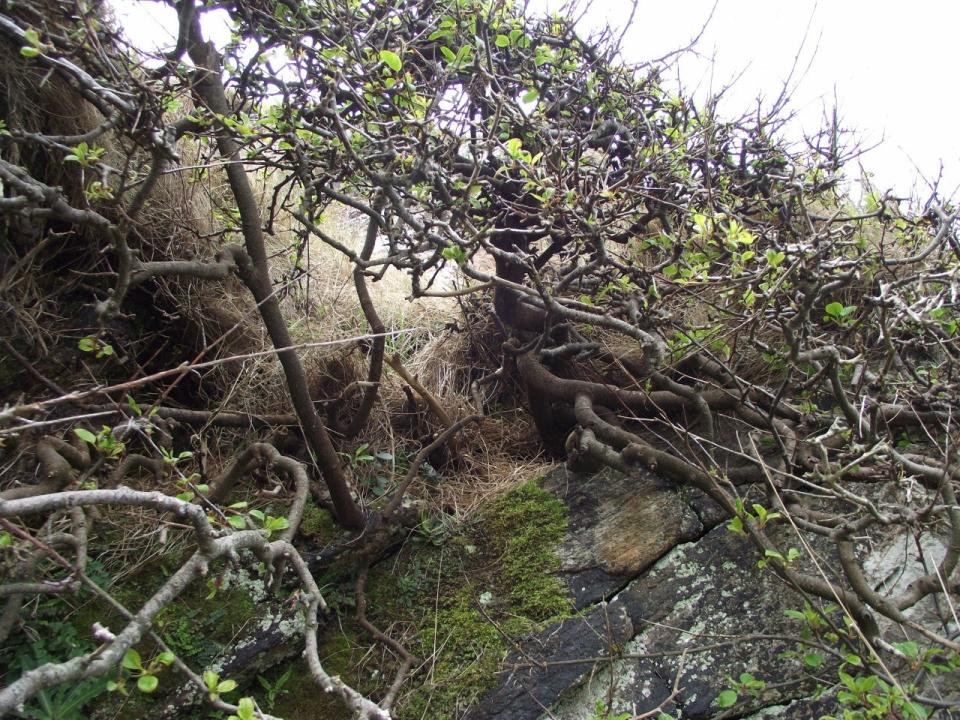Mysterious lonely apple tree on uninhabited Hebridean island baffles scientists
Hidden amongst mossy crags on an uninhabited outer-Hebridean island of Scotland’s west coast, a rare example of a pure European crab apple tree species has been surviving, likely since the end of the last ice age, scientists have suggested.
The single lonely tree was first discovered by botanists in 2003 on a rocky outcrop on the island of Pabaigh Mor, which lies off the wild west coast of Lewis, and its highly remote location has baffled scientists.
The tree is growing at what is believed to be the northwestern limit for the species, with only one other similar case known – another single apple tree found over 200 miles away on an inaccessible cliff in Shetland.
Now, scientists have examined the tree’s DNA, and discovered it is a “pure” species of European crab apple, which has never been cross pollinated with modern species, and it represents a type of apple tree which colonised the British Isles and other parts of Europe after the last ice age.
Crab apple trees have a lifespan of up to around 150 years, and the possibility of a seed reaching the outer hebrides by animal or human is unlikely, the scientists said, as neither birds nor humans consume crab apples.
Dr Markus Ruhsam, molecular ecologist at the Royal Botanic Garden, Edinburgh, told The Independent: “We’ve been looking at wild apple trees in Scotland for around three years, and the idea is to establish how pure the wild apple trees we find in the countryside are.
“All over Europe there is a lot of hybridisation between the wild apple tree and the domesticated apple tree, and we wanted to establish how pure it is.”
Other recent reports have suggested the tree itself may be 11,000 years old. Dr Ruhsam said this was not the case. “Dating back to the ice age is not quite correct. There must be a misunderstanding,” he said.

“When the glaciers retreated, those wild apple trees came back into Britain, but that particular tree certainly doesn’t date back to the ice age. They are rather short-lived - a hundred, a hundred and fifty years or so.”
The researchers examined what are known as “microsatellites” – small pieces of DNA which help identify species. The microsatellites help distinguish cultivated apple from wild apple.
“When we looked at enough pieces of DNA, we can see whether the tree is pure, or whether there has been hybridisation going on in its past (where insects cross pollinate the tree with cultivated species). But it came out as pure,” Dr Ruhsam said.
“The amazing thing is that we don’t have many records from the west coast of Scotland of pure trees, and certainly none from any of the islands.
“The first question is how did it get there - it’s definitely not apple country. It’s in the rocks in a windswept place. It’s a very unusual place to find an apple tree. There’s another one on Shetland, but it’s very rare to find these trees.”
The exact age of the tree is not known. Paul Smith, plant recorder for the Outer Hebrides for the Botanical Society of Britain and Ireland, told The Independent: “It’s age isn’t worked out because there are no bits that will have persisted long enough to be dated.
“It is however, quite likely that it regularly puts up new branches as old ones die off, and therefore that it will have persisted in the same place for a long time. It is more likely that a small population, rather than this particular plant, has persisted here, though since no other individuals are known here, it’s not certain that this is so. But it is a native and not a domesticated apple.
He added: “If it’s not a persistent native, it would be likely to have come by human agency when Pabaigh Mor was inhabited.
“But it still seems an unlikely place for a seed to be deposited and grow in this case.”
He suggested the existence of the Shetland tree backed up the idea that the trees are part of populations which have survived since the last ice age.
Read More
One million football fields and the entire Grand Canyon: This is how big US and Canada wildfires are
Hundreds of syringes wash up on New Jersey beach after Hurricane Elsa

